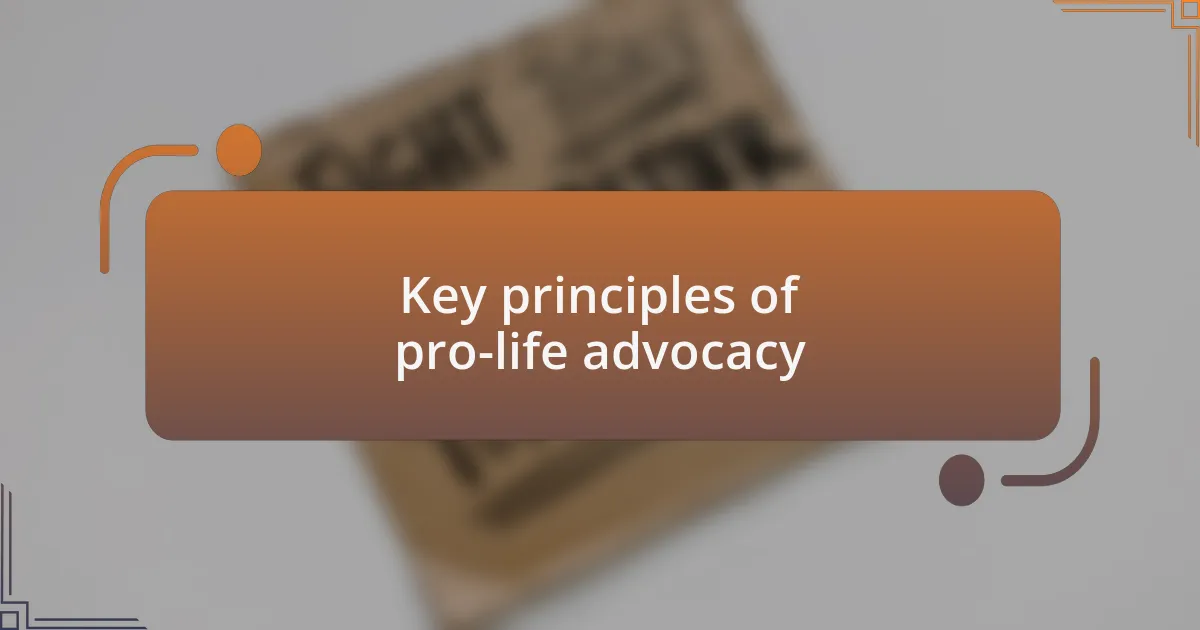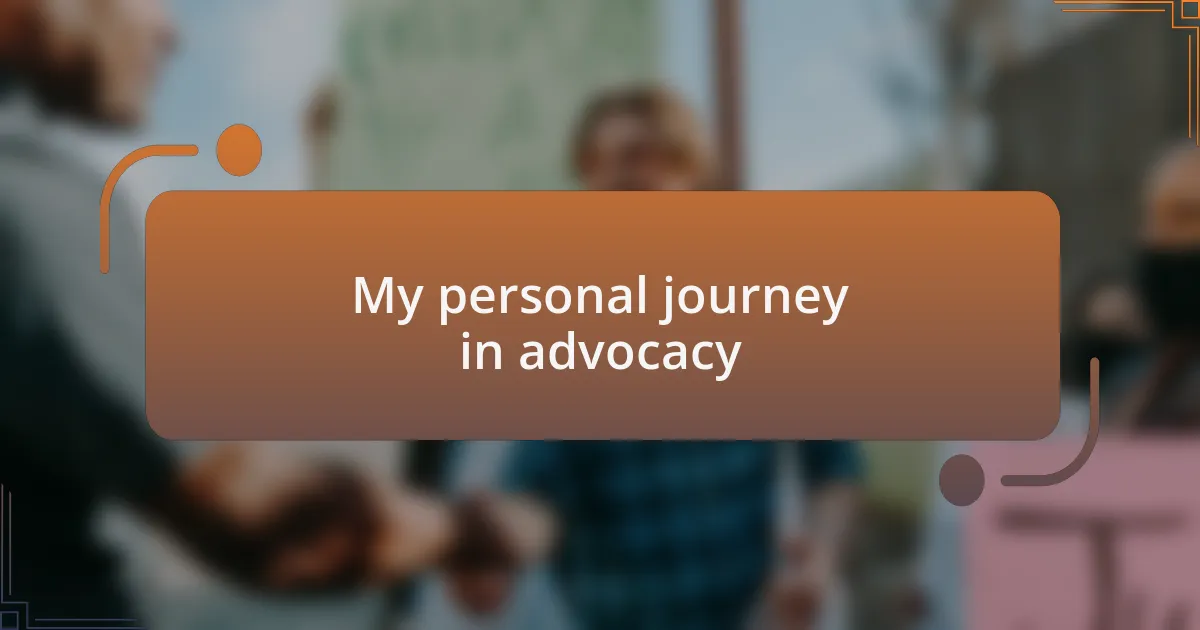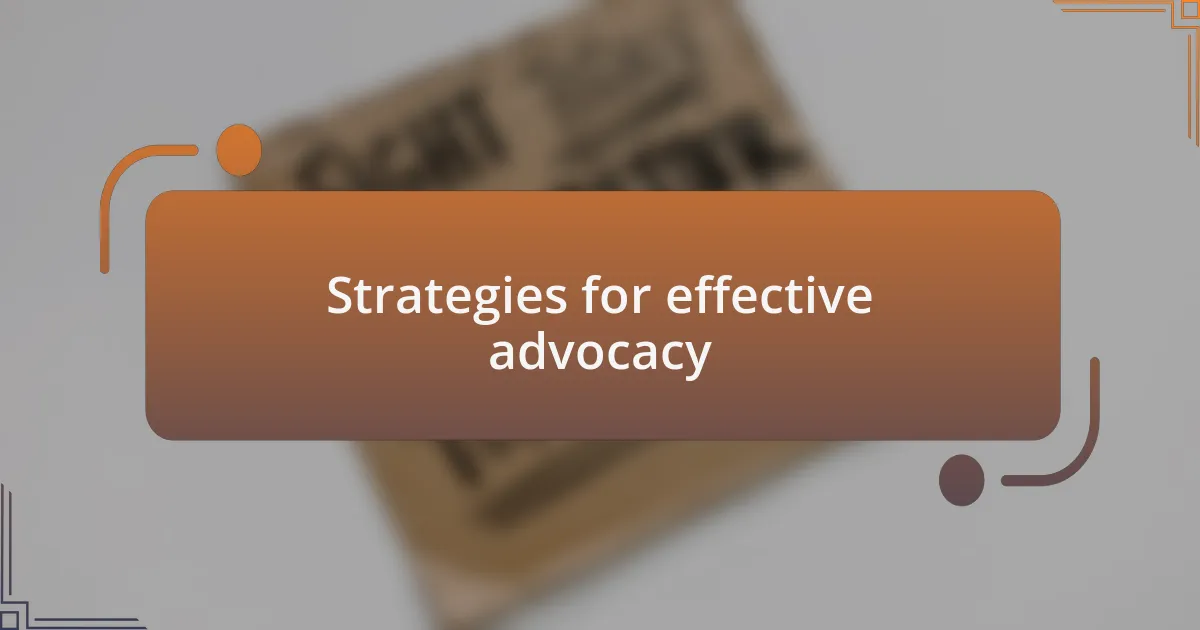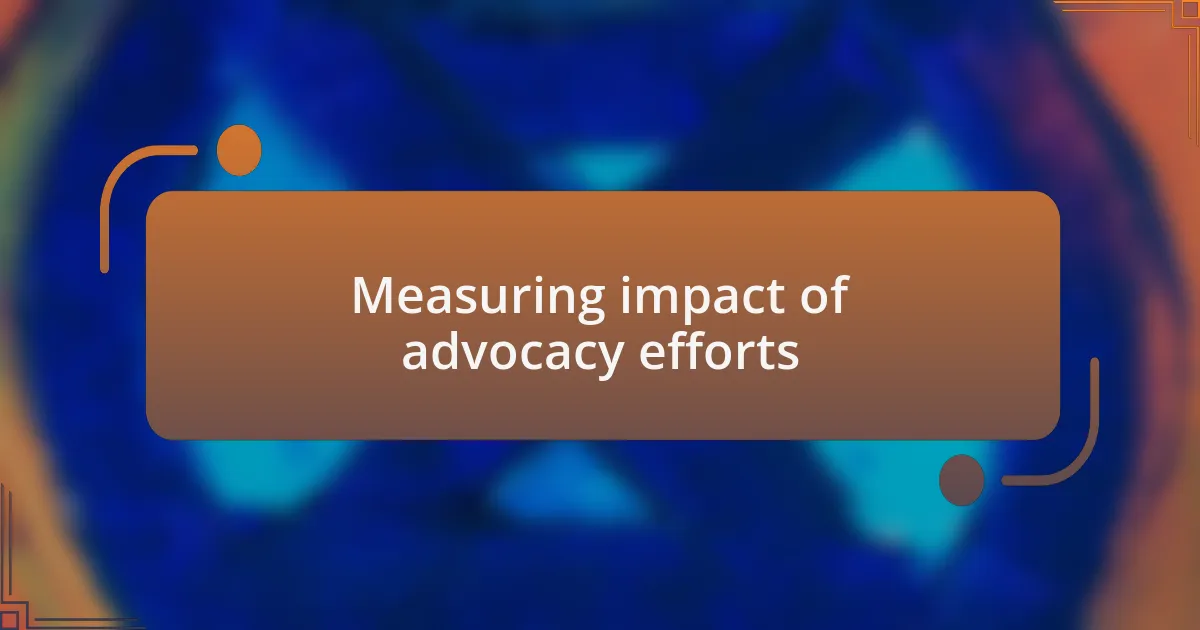Key takeaways:
- Community advocacy thrives on relationships and listening to diverse perspectives, fostering understanding and solidarity.
- Pro-life advocacy emphasizes the dignity of life, creating a culture of compassion and potentially influencing policy changes through collective action.
- Effective advocacy involves building genuine relationships, utilizing storytelling, and collaborating with like-minded organizations to amplify impact.
- Measuring advocacy impact is essential through feedback and tracking engagement, reinforcing the significance of personal stories in driving change.

Understanding community advocacy
Community advocacy is about actively engaging with others to promote change and support shared values. I’ve seen firsthand how a single conversation can spark motivation within a group. Have you ever felt that rush of inspiration when discussing a cause you care about? It’s incredible how collective efforts can create a ripple effect, driving meaningful discussions and actions within a community.
At its core, community advocacy thrives on relationships. I remember attending a local event where I met individuals passionate about the pro-life movement. Listening to their personal stories and experiences opened my eyes to the diverse perspectives within our community. How often do we take the time to truly listen to each other’s stories? This genuine exchange fosters understanding and solidarity, making advocacy efforts more impactful.
Moreover, community advocacy is a continuous learning process. Every interaction teaches me something new, whether it’s about the struggles others face or the strategies they use to promote their message. I often reflect on the challenges and successes we encounter together. Isn’t it empowering to know that, by sharing our knowledge and experiences, we can equip one another to advocate more effectively?

Importance of pro-life advocacy
Pro-life advocacy holds immense significance because it champions the intrinsic value of every human life, reminding us of the potential each individual possesses. I recall a poignant moment during a community gathering when a young mother shared how support from pro-life advocates helped her choose life for her unborn child. Those moments emphasize how vital our efforts are in providing hope and encouragement to those facing difficult decisions.
Furthermore, advocating for pro-life principles nurtures a culture of compassion and understanding. I often ponder how we, as advocates, create spaces for dialogue where differing opinions can coexist. Engaging with others about the pro-life stance encourages education and empathy, transforming opposition into understanding. Isn’t that what advocacy should be about—bridging gaps rather than deepening divides?
Lastly, pro-life advocacy plays a crucial role in influencing policies that protect and affirm life at all stages. I’ve participated in community campaigns that lobbied for legislation supporting pregnant women and families. These experiences have highlighted how collective voices can drive legislative change, showcasing the power of advocacy in shaping a society that values life. When we unite our voices, we amplify those who often feel voiceless, reinforcing the importance of our commitment to this cause.

Key principles of pro-life advocacy
A core principle of pro-life advocacy is the affirmation of life’s dignity from conception to natural death. I remember attending a seminar where a speaker passionately described how every heartbeat signifies a life deserving of respect. It struck me deeply—how often do we overlook the miracle inherent in early life? Advocating for this principle compels us to recognize the humanity in every unborn child, nurturing a culture that respects and values life at all stages.
Another critical aspect is fostering a supportive community that offers tangible resources to those in need. During one campaign, I witnessed the transformation of a distressed individual who found solace and guidance through our local pregnancy resource center. It made me realize that advocacy is not solely about ideals; it’s about taking actionable steps to ensure women and families are equipped with the support they require. How can we genuinely advocate for life without extending our hands to help those who feel most vulnerable?
Engaging in open and honest conversations is also paramount. I often reflect on my own experiences debating with friends who held opposing views. Those dialogues were not always comfortable, but they taught me the importance of listening and sharing perspectives respectfully. Isn’t it fascinating how discussing differing beliefs can plant seeds of understanding? By fostering such conversations, we promote a more inclusive discourse around pro-life principles, inviting others to explore new viewpoints in a compassionate atmosphere.

My personal journey in advocacy
In my journey of advocacy, I vividly recall the first time I volunteered at a local crisis pregnancy center. It was eye-opening to meet women facing enormous challenges who were seeking support. Their stories often left me feeling a mix of heartbreak and hope, pushing me to become more involved. It made me question, what more can I really do to uplift and empower these individuals during such critical moments?
One powerful experience that stands out happened during a community event where I spoke about the joy of parenting. I shared my own journey of becoming a parent, emphasizing the unexpected blessings that come with it. The audience’s response was moving; several people approached me afterward, sharing their fears and hopes regarding pregnancy. It struck me how personal connection can shift perspectives—could my story be the key to inviting someone to reconsider their own views on life and choice?
As I reflect on my advocacy, I realize that it’s not just about promoting pro-life principles; it’s about embracing vulnerability. I’ve often encountered resistance and skepticism, which can be discouraging. However, those challenging moments have taught me resilience. I often ask myself, how can I turn these obstacles into opportunities for growth? Each setback has inspired me to refine my approach, ensuring that my voice continues to resonate with compassion and understanding.

Strategies for effective advocacy
One effective strategy I’ve found in advocacy is building genuine relationships within the community. I remember attending a local health fair, where instead of just sharing flyers, I took the time to listen to the concerns of attendees. Engaging in heartfelt conversations helped me to understand their perspectives better. It prompted me to ask, how can I truly support their needs in a way that aligns with my pro-life values?
Another important tactic is utilizing storytelling in advocacy efforts. I’ve learned that sharing relatable experiences can bridge gaps and challenge preconceived notions about pregnancy and parenthood. For instance, during a workshop, I recounted a poignant moment when I witnessed a friend’s transformation through motherhood. Seeing her growth sparked a lively discussion on how support can change lives; it made me wonder, what if more people heard stories like hers?
Finally, collaborating with like-minded organizations can amplify our impact. I’ve participated in joint events with various groups that focus on empowerment, education, and support for expectant mothers. These partnerships not only broaden my reach but also foster a united front; it makes me think, how can we leverage our collective resources to create a more supportive environment for those in need? Each strategy I employ helps to cultivate a culture of compassion and understanding.

Engaging others in advocacy
Engaging others in advocacy often starts with inviting them into the conversation. I recall a time when I organized a small roundtable discussion in my living room, bringing together friends and community members who had varied opinions about pro-life issues. Initially, I was nervous, unsure of how to encourage open dialogue. Yet, as each person shared their experiences, I felt a collective understanding grow. It made me realize that sometimes, all it takes is a safe space to spark meaningful discussions.
Another effective way I’ve engaged others is by leveraging social media platforms. There was a time I posted a thought-provoking quote on my page about the value of every life. The dialogue that ensued caught me by surprise; my friends started sharing their own thoughts and stories, often tagging each other for further discussion. I found it fascinating to see how one post could lead to a cascade of conversations that opened minds. Have you considered how digital platforms can become a springboard for dialogue in your own circles?
Sometimes, it’s about simply being present and visible within your community. I often attend local events, not only to advocate but also to mingle and connect with others who care deeply about shared values. Just last month, I volunteered at a community breakfast, where I engaged with attendees in casual talks. It reinforced for me that advocacy isn’t always about loud proclamations; sometimes it’s quietly being there, fostering relationships. Doesn’t it make you wonder how many connections we might create just by showing up?

Measuring impact of advocacy efforts
Measuring the impact of advocacy efforts can be complex, but I believe that gathering feedback is essential. For instance, after hosting an advocacy workshop, I sent out a brief survey to participants to understand how the experience resonated with them. The responses were eye-opening; many expressed not only a deeper understanding of the issues but also an eagerness to get involved further. Have you ever considered how direct feedback can shape your future advocacy strategies?
In another instance, I collaborated with local clinics to track the progress of our educational campaigns. By analyzing the increase in appointment requests and community interactions over a few months, I was thrilled to see a tangible shift in engagement levels. It felt rewarding to know that our efforts were making a difference in how people perceived and accessed resources. Isn’t it empowering to see the fruits of your labor reflected in real-world actions?
Moreover, I often reflect on the conversations I have after speaking publicly about pro-life issues. When attendees approach me to share how my words influenced their thoughts or decisions, it reinforces the importance of our work. Each story is a reminder that advocacy is more than statistics; it’s about personal stories that signify real change in people’s lives. Does that not highlight the true power of effective advocacy?